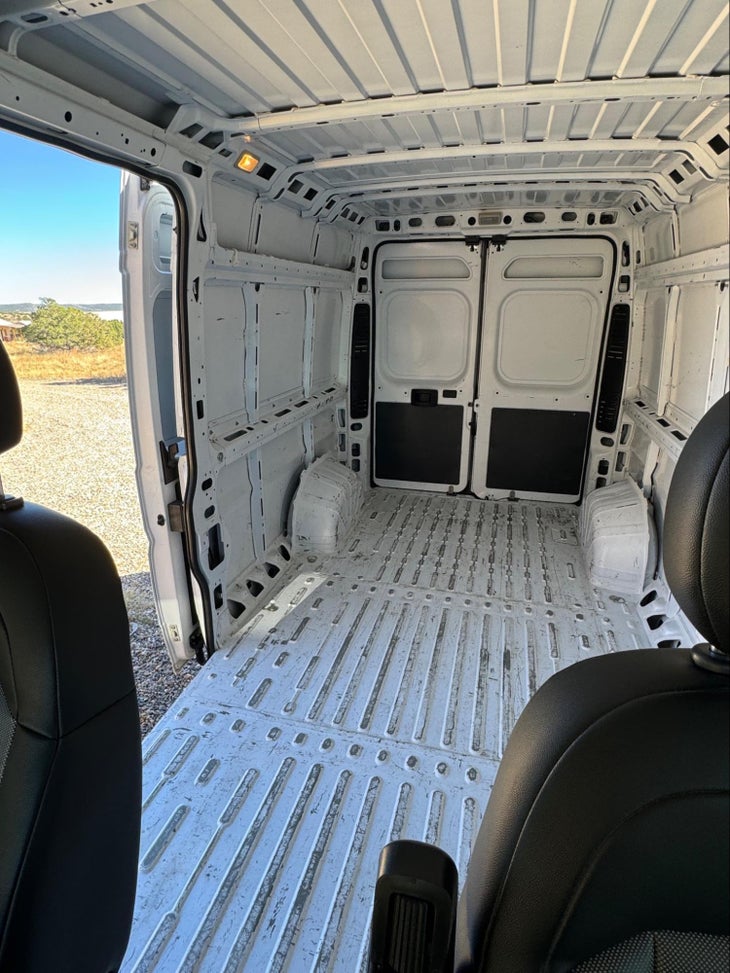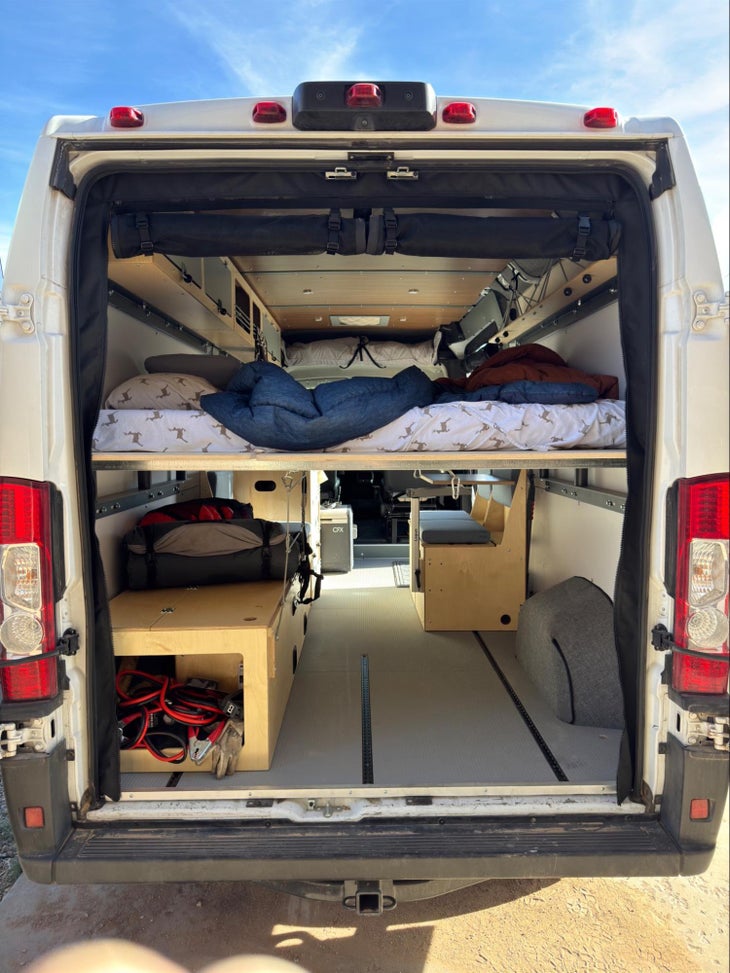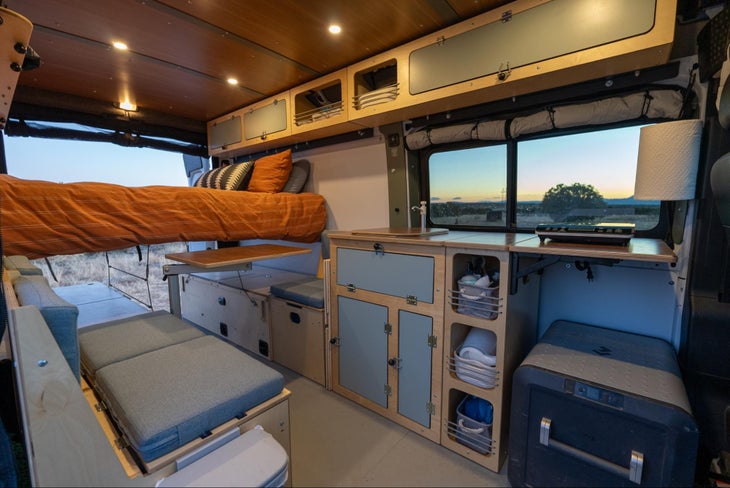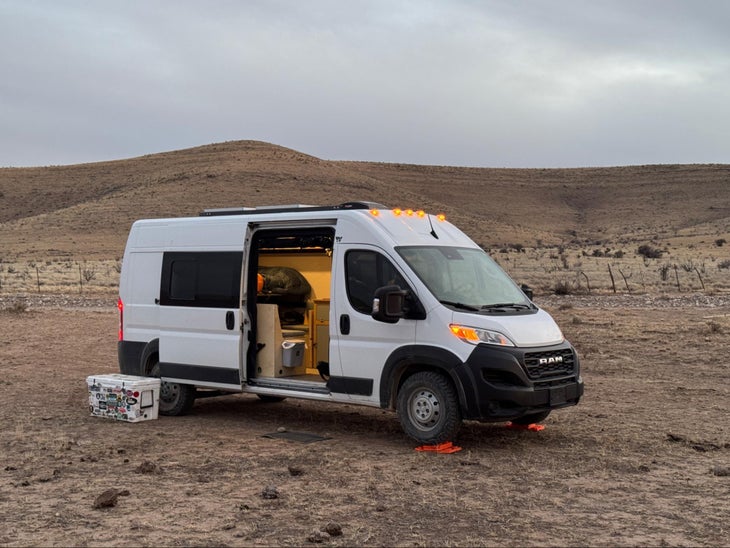
If you’re a regular reader of this column or have followed my adventures over the years, you’ve no doubt realized that I have a habit of changing adventure rigs quite often. My wife says I have a problem, but I think it’s fun to try new camping rigs and, as with most other outdoor gear, constantly tweak and dial them in.
Our latest rig is a camper van. Sarah and I tested a Wayfarer Vans Walt conversion last summer, and we liked van camping and traveling so much that we pulled the trigger on a van of our own late last year. After five months with it, I have a better sense of how a van compares to different types of rigs, and thought I’d break down why we made the switch.
Watch: Inside a Wayfarer Vans Conversion
Why We Made the Switch
First, some quick background. I spent six weeks last summer riding the Great Divide Mountain Bike Route (GDMBR), and Sarah joined me in the Wayfarer test van for the last two weeks of the trip. While planning the adventure, we began discussing logistics and what vehicle she’d take. The natural choice, to me, was to take our Tundra and 19-foot Airstream—but after talking it through, it became clear that towing the trailer would be too much work and create a lot of unnecessary headaches. I suggested she just camp in the Tune M1 that lives on the back of our Tundra, but we haven’t built out the inside, and she rightly pointed out that living and working out of it for several weeks wouldn’t be comfortable.
All of that led to our interest in trying a van. We quickly learned that a van was not only the right rig for that particular trip—which involved moving to a new location every day and lots of highway driving—but it made more sense for the majority of our trips than the Airstream. Here’s why:
- We averaged 20mpg over a couple thousand miles, which is nearly double what our truck gets pulling the trailer.
- Navigating cities, small towns, and even gas stations was infinitely easier with a van half the length and with a better turning radius. While the Airstream was only 19 feet long, when you add it to the truck’s length, you’re piloting a 38-foot rig versus a 19-foot van.
- We worried significantly less about getting stuck or having to back up for long distances on Forest Service roads. Even though our trailer has a 3-inch lift and all-terrain tires, the whole rig was much more difficult to fit in tight spaces than a self-contained van.
- The van, despite being front-wheel drive (FWD), proved quite capable and went anywhere we needed to go. The GDMBR is made up of mostly dirt roads, some of which get pretty gnarly—especially in New Mexico and Montana. There were some particularly rough, rocky, and rut-strewn sections of Forest Service road between Seeley Lake and Whitefish that the van probably had no place being, but Sarah took it slow and made it through without issue.
- The Wayfarer build was simple, high quality, and offered most of the amenities we were used to with our Airstream, such as running water, lights, a heater, and a fridge—just with much less required maintenance.

The unfinished interior of a Ram Promaster van before the Wayfarer build. (Photo: Bryan Rogala)
Choosing the Van
When we got home from that trip and returned the test van, we were surprised by how much we missed it. We didn’t just miss camping out of it—we missed all the little advantages that come with having a campervan, like the passthrough from the cab to the living area and ability to make quick snacks in the kitchen on the road. So, we decided to sell the trailer and look for a van.
We were set on a Wayfarer conversion after spending so much time in one, which limited our van choice to either a Ram Promaster or Ford Transit. I labored over the decision mainly because the Transit is available in all-wheel drive, and I thought that might be necessary for some of the places we go. Ultimately, we decided that a van with all-wheel drive would still be nowhere near as capable off road as the four-wheel-drive Tundra in our driveway. The low clearance, limited suspension travel, overall size, and lack of low range really limits where an AWD van can go compared to a truck, so we decided to skip it. Besides—we’d already found the Promaster’s FWD to be capable of getting to most places we wanted to visit on our trip along the Divide.
Promasters can cost significantly less money than AWD Transits: A brand new, 159” High Roof Promaster 2500 starts just over $50K, while a 148” High Roof, AWD Transit starts around $57K (though when you dig into it, it’s very difficult to find a 148” High Roof, AWD Transit for less than $65K). Used Promasters are even less expensive, and when we were shopping it was easy to find a slightly used Promaster with 30,000 to 40,000 miles on it for $30K, which was a big factor in our decision. What really sold me on the Ram was the dimensions. First of all, Promasters are more square inside and feel much more roomy to me than Transits, which get narrower toward the roof. At their widest points, Promasters are about 7.5 inches wider. A high-roof Promaster has about 6 feet, 2 inches of standing room inside after a Wayfarer conversion, but its exterior height is a full 8 inches shorter than a high-roof Transit (which, despite the tall height, only offers 2 more inches of interior head room). That might not sound like a big deal on paper, but I can assure you it makes a difference in high winds on the highway, low overhangs around town, and low-hanging branches on dirt roads. Heck, a mid-roof Transit, which only offers 5 feet 8 inches of standing height, is only 3 inches shorter than a high-roof Promaster.
There isn’t really enough of a difference in payload and towing capacity between the two makers to really matter, but Promasters get better fuel economy than the AWD Transits, which was important to us (we average around 18 to 20mpg in ours, while the AWD Transits usually average 13 to 15mpg). They also have about two more inches of ground clearance from the factory than the Fords.
There seems to be a consensus on the internet that Transits are more reliable than Promasters. While data from Repairpal does sort of back that up, the Ram’s listed annual cost of ownership number is only $200 more, which wasn’t enough to sway me in the Ford’s direction given the Transit’s higher purchase price and lower fuel economy. I also asked the folks at Wayfarer about their experience with both vans, and they said from what they’ve seen and heard from customers, there really isn’t that much of a difference between the two in terms of reliability. Both vans are sold all over the world, and there are plenty of examples of people traveling extensively out of each van with great success.
Ultimately, we chose to buy a used, 2023 159-inch wheelbase, high-roof Ram Promaster 2500. We opted for a 2023 because that model year came with a new, nine-speed transmission, which helps the van’s 3.5L V-6 on the highway and in the mountains. We really appreciated the amount of space it had inside over the Transit, and were able to save a bunch of money by finding a great deal on a used van. Side note: Wayfarer is one of very few van conversion companies that will actually convert used vans.

The Build Process
Wayfarer Vans is based in Colorado Springs, and they have their conversion process down to a science. They can help you source a van, and once you’ve got one, lead times vary from two to eight weeks for scheduling your install. Installs themselves usually take just two to three days.
Each Wayfarer conversion is based on the van model you bring them, so our high-roof, long-wheelbase Promaster meant we’d be going with the same Walt conversion we tested. We optioned ours a little differently than the test rig, but it’s quite similar overall. The biggest-ticket options we wanted were the windows, bug screens, and heater.
Because we were moving from a 19-foot Airstream to a van, we really appreciated the Walt’s extra storage space for gear and extra seating. The Walt has one extra “Boot Box” in the back compared to the Transit models and a larger galley cabinet for more storage. We often camp with friends, and being able to easily seat four or five people for dinner or board games inside the van if it’s nasty outside is awesome. As a side note, you can also spec either van with a single or double rear seat if you have kids or travel with more than two people.
You can read a more detailed account of the van’s interior build in this article I wrote last year, but the moral of the story is that Wayfarer builds simple, high-quality camper vans that are completely modular and allow you to change the layout of the van depending on your needs.

Top Takeaways
We’ve had the van for nearly five months now, and it’s already gotten more use than our Airstream did in the several years we owned it. That’s because now, in addition to a sweet camper, we also have a supremely practical vehicle that we use for other things than just camping trips. We’ve hauled appliances and kitchen cabinets, driven to visit family across the country, used it as a production vehicle for my video business, and even used it as a daily driver because it gets better fuel economy and is easier to park than the truck.
I was also used to constantly working on the various systems in our Airstream, given it was 20 years old: I ripped out the black tank and replaced the toilet with a composter, lifted it and added bigger tires, added lithium batteries and a solar system, and more. With the Wayfarer build, we still have running water, a heater, lights, vent fans, solar-powered electricity, and even a portable composting toilet, but it’s all simpler and everything just works. It has a hand pump that pulls water from a 5-gallon jug, so there’s no winterization required. The electrical “system” consists of a Goal Zero Yeti 3000, which works flawlessly and is simple to replace if it somehow wears out. All of the cabinetry is high-quality, Baltic birch plywood that’s completely modular and can be easily repaired or replaced if necessary. In practical terms, that means I now spend a lot less time futzing with systems and more time planning trips and actually camping.
We’ve also found that it’s an infinitely better winter and ski camping rig than the trailer, due to the superior insulation, lack of plumbing to freeze, maneuverability and the fact that we are no longer dealing with trying to tow a trailer on snowy roads. The front wheel drive, paired with the Nokian Hakkapaliitta snow tires I ran on it this winter, have proven to be totally capable of getting us to our favorite ski hills.
I’ve already mentioned how practical the van is for more mundane tasks like moving furniture, but we’ve also found that it makes for the perfect dog palace at trailheads or when running errands around town. The fans and windows allow us to keep it cool inside if we need to leave the pup in the van for a bit, and he’s got a comfy bed and a full bowl of water at his disposal. Bonus: The fact that there’s a Dometic fridge always inside means we can keep groceries cool if we’re in town for the day, or just have cold drinks waiting for us after a mountain bike ride.

Off-Road Capabilities
But what about off-road stuff? You can’t do that in a Promaster! While the Promaster is an exceptionally practical vehicle, it’s also true that a huge, front-wheel drive, box on wheels is not an off-roader. But honestly, that’s part of what I love about it—it doesn’t pretend to be one, unlike some other vans out there. Despite that, it will absolutely get you down a gravel or moderate dirt road, which, if we’re honest, is really what most of us do with our built-out trucks, anyway. I do plan to modify mine just a bit to make it more dirt-road capable, which I’ll cover in an upcoming article.
If I know I’m going somewhere that the roads will be really rough, I’ll take the truck and sacrifice some camp comfort. I also love that the van also gives me the option to bring my e-bike or tow a four wheeler for further exploration (both of which will get further off road than my truck ever could).
Gear Hauling and Practicality
One other point in the win column for the Promaster is its gear hauling ability. Our van can not only tow more than 6,000 pounds, but has a payload capacity of 3,994 pounds. After the lightweight Wayfarer build, that means we still have plenty of payload leftover for toys and never have to worry about overloading the rig, which is something we’re constantly mindful of with our truck. If you’re an overpacker like me, a ¾-ton Promaster is a great option and can usually be found for significantly less money than an equivalent ¾-ton pickup truck.
If I’ve learned one thing in all the years of testing rigs, it’s that no adventure vehicle is perfect. I always shied away from vans mainly because I assumed you needed at least $150K to buy one. Downsizing from a 19-foot travel trailer to a Promaster and Wayfarer conversion taught me otherwise. It’s also teaching me that, as with most things in life, simple is better.
More Gear Reviews
The Best Trailers, Truck Campers, and Van Conversions of 2025
The Most Exciting New Gear at Overland Expo West 2025
The 7 Best Sleeping Bags for Car Camping
The post Takeaways from Camping and Traveling in a Van Versus a Trailer appeared first on Outside Online.















